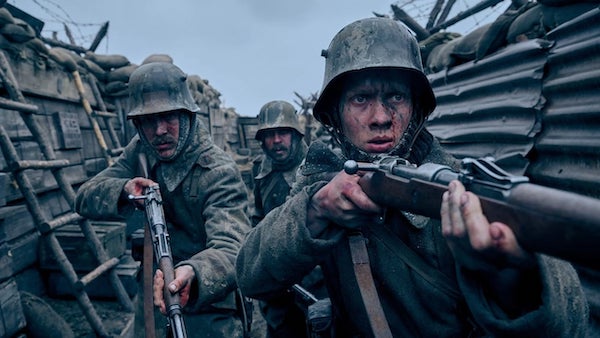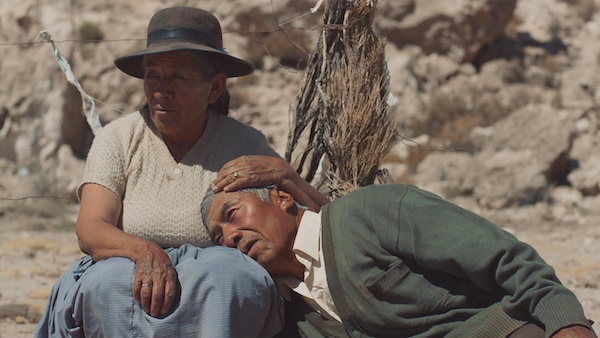Film Review: Wastelands then and now — “All Quiet on the Western Front” and “Utama”
By Peter Keough
Two recent film releases, both submitted by their countries for the Best International Feature Film Oscar, offer variations on no-man’s-land.

A scene from the latest adaptation of Erich Maria Remarque’s 1928 novel All Quiet on the Western Front.
T.S. Eliot’s poem “The Waste Land” celebrates its centennial this year and not much has changed in the past hundred years to ameliorate his vision of a fragmented, vicious, and desolate human condition. Coincidentally, two recent film releases, both submitted by their countries for the Best International Feature Film Oscar, offer variations on Eliot’s central conceit.
The poem sprang up in the aftermath of World War I, the horror and devastation of which was recorded in works such as Erich Maria Remarque’s 1928 novel All Quiet on the Western Front. German director Edward Berger’s adaptation (available on Netflix). is the third following Lewis Milestone’s superb 1930 version and Delbert Mann’s adequate 1979 made-for-TV effort. It is also the weakest because it jazzes up the production values, adds horror movie flourishes on the soundtrack, heightens the gore, ratchets up the pat ironies, and interjects scenes of quasi-historical context.
The latter includes a preamble of sorts set in Spring, 1917 in which an invented soldier identified as Heinrich Gerber reluctantly goes over the top, charges across no-man’s-land past blasted comrades, whizzing bullets, and exploding shells, and dispatches a Frenchman with the razor sharp edge of his entrenching tool. Then, with a freeze frame, he is no more.
So much for Heinrich, but his uniform lives on. It joins the thousands of other uniforms stripped from the dead (“so many,” as Eliot writes, referencing Dante, “I had not thought Death had undone so many”). These are laundered, with bullet holes mended by phalanxes of seamstresses, and sent to recruitment centers. At one of these Paul Bäumer (Felix Kammerer), a zealous (though after three years of stalemate and millions of casualties this seems unlikely — in the book and other films he joins up when the war begins) 17-year-old, proudly accepts his. But he notices a tag with someone else’s name. Probably was the wrong size for him, says the recruiter, rips off Heinrich’s tag, and drops it on the floor into a pile of others.
This is a one size fits all war and individuals don’t matter. In keeping with that spirit, perhaps, they don’t figure significantly in the movie, either, and the characters, Bäumer included (though Kammerer’s features are distinctive despite the mud and mugging), blur into cliches. As in Christopher Nolan’s Dunkirk (2017), which the film resembles stylistically when it is not echoing Stanley Kubrick’s Paths of Glory (1957), all of the soldiers appear alike and their inevitable passing, ironic touches notwithstanding, leave little impression.
Except for one. In a scene that is central to the book and in every adaptation including this one, Bäumer stabs a French soldier who has the bad luck to jump into the same shell hole in which he shelters. The stranger does not die easily, and after stuffing his mouth with mud to stifle his groans Bäumer realizes the enormity of his act and pathetically tries to make amends. He futilely dresses the wound and looks through the man’s belongings finding the inevitable photo of the wife and child. He promises to contact them… and tell them what?
It doesn’t matter. At this point both men are identical, coated in the fetid, viridian green muck of the battlefield, the waste land that is their world. Berger depicts with awe and terror the endless landscape of craters, corpses, pools of red, wreckage, and death. It comes alive during scenes of battle – in one climactic sequence a French counterattack with monstrous Saint-Chamond tanks and squads of soldiers with flamethrowers evokes both the AT-AT walkers in The Empire Strikes Back (1980) and Bruegel’s “Triumph of Death” (1562). But at times that world can appear serene, even consoling — and that is when it is deadliest.

A scene from Utama, Bolivian photographer Alejandro Loayza Grisi’s feature debut.
Eliot did not have today’s pending climate catastrophe in mind when he wrote his poem, but lines like “Here is no water but only rock/Rock and no water and the sandy road” suggest a vision not unlike that which opens Bolivian photographer Alejandro Loayza Grisi’s feature debut, the stark parable Utama (opens at the Brattle November 18). Old and weathered Virginio (José Calcina Sisa) of the indigenous Quechua people walks along the parched landscape of the Bolivian highlands towards a toxic yellow sunset. The drought has left little water for his herd of llamas, comic creatures with whimsical pink tassels on their ears, nor for the desolate garden his wife Sisa (Luisa Quispe) tills. The mud in All Quiet on the Western Front would be welcome here.
They live in a roughhewn ranch house and the view out the window and door, with the sun-bleached emptiness blazing in, so resembles similar scenes in John Ford’s The Searchers (1956) that I’d be surprised if Grisi had not been influenced by that film. The Bolivian highlands might be his Monument Valley. Be that as it may, the old couple are not searching for something but are waiting for the rain to come and restore the land to life.
What they get instead is a visit from their grandson Clever (Santos Choque), who has come from La Paz with a mobile phone and storebought goods in tow to ask that the two come with him to the city to live. Though Sisa is delighted to see the young man, Virginio greets him with hostility. He calls him a “brat” in their native language, which is one of the few words the citified Clever remembers from his origins. Apparently bad blood simmers between Virginio and his son, Clever’s father, who abandoned the ranch to seek a better life. So Virginio refuses to go with Clever, saying they are doing fine — his ailing herd and his own ominous cough suggesting otherwise. Though troubled by her husband’s condition and his stubborness, Sisa remains silent.
Despite his grandfather’s irascibility Clever decides to stick around and help out. He follows surly Virginio with the flock into the wastes in search of forage and later joins him as he and other locals head to the mountain to sacrifice a llama to bring the rains.
But even the glaciers on the mountains have dried up. It will take a different kind of sacrifice to bring relief. In the end Sisa is seen shepherding the flock across the desert and from the mountains thunder can be heard.
Peter Keough writes about film and other topics and has contributed to numerous publications. He had been the film editor of the Boston Phoenix from 1989 to its demise in 2013 and has edited three books on film, most recently For Kids of All Ages: The National Society of Film Critics on Children’s Movies (Rowman & Littlefield, 2019).
Tagged: Alejandro Loayza Grisi, All Quiet on the Western Front, Edward Berger

a very cerebral review, thank you
Great piece. I found ALL QUIET ON THE WESTERN FRONT very moving and beautiful.
I watched the film (in German) and was very disappointed. The touches of humanity which make the book and the 1930 Milestone adaption so poignant (the encounter with the girls bathing, reaching out to touch the butterfly etc ) are gone & replaced by a CGI slugfest which quickly becomes tedious.